2017 proved a very different “WDYTYA? Live” show experience for me on a number of counts. The major shift this year, instead of cramming everything into one day including the travelling, I did the full three days and stayed within walking distance of the NEC. It made for a far more relaxed, sensibly paced visit, with plenty time to chat, plan, rehydrate, refuel and rest. No running round like an episode of “Challenge Anneka” #ShowingMyAge.
It meant I could visit all the exhibitors I planned to see and more besides. I’m not saying I didn’t forget things – on the journey home I realised I’d not made use of a £5 voucher I’d picked up with one of my purchases. But there were very few “kick myself” moments on that homeward journey.
As ever a wide range of exhibitors and experts were present, representing a breadth of family history aspects. From the big dataset providers, genealogy and software suppliers to Family History Societies and the archives sector. From companies providing family history courses to professional organisations and publishers. Niche interests were represented too such as theatrical ancestors, the ShipIndex for researching vessels associated with ancestors and the Canal and River Trust: The Waterways Archive, described as “a treasure chest for anyone with waterways’ ancestors”. There’s the international aspect too. Not just England, Ireland, Scotland and Wales but Belgium, Luxembourg, France, the Netherlands, Germany, Poland, the Caribbean and Canada.
An aside, not sure if this was just my perception, but did there seem to be far more non-family history related stands this year? I really wouldn’t like this to get out of hand in future and detract from what is the country’s largest family history show. The military sector was there in force, fittingly including ancestral tourism such as Mons Memorial Tourism, in this period of centenary commemorations. In addition were the excellent displays by Dig for Victory and The Battlefields Partnership. At the latter I achieved a long-held ambition to hold a Short Magazine Lee-Enfield (SMLE) from the Great War. My arm and shoulder ached afterwards – it was quite heavy and I was fairly slow on the uptake as to what to do. The MoD stand proved of particular interest to me. TNT Archive Services, which holds those as yet unreleased MoD service records (essentially 1920 onwards depending on rank) had a database where you could ask them to search for a record of interest. I had a few to check, and confirmed they held them all, including records for those who did National Service. I definitely intend applying for two of them but I’m holding off for now. During the show Chris Baker, military historian, researcher and author, tweeted: “MOD saying today that an exciting announcement concerning post-1921 army service records is soon to be made”. So is this a transfer to The National Archives, or a digitisation project enabling speedier access? I’m waiting to see. As ever you could always seek expert help in interpreting finds, breaking down brick walls, finding pointers for further research and identifying and dating family treasures and photos. Besides the Military Checkpoint manned by a range of military museum specialists, the popular Ask the Expert area returned for wider queries as did show stalwart Eric Knowles with his Heirloom Detectives section. There were however some notable absentees amongst the major players, who I really expected to have a presence at this prestigious annual national event. These included The National Archives, The Imperial War Museum, Forces War Records and Fold3. Yes, money is tight, the public and charity sector have taken massive Government funding cuts, and having a presence at these events does not come cheap. And yes, others may be off-shoots of bigger companies. But I really was disappointed not to see them at the show, and I think many others will share that sense of disappointment.It wasn’t as if all Government departments were absent. The MoD turned up, as did the General Register Office. I’m still thinking about ordering a couple of certificates in Phase 3 of their trial, those certificates not held in a digital format (births 1935-2006, deaths 1958-2006 and marriages 1837-2010). They were apparently overwhelmed by Phase 1, the £6 PDFs of those certificates digitised under the now suspended DoVE (Digitisation of Vital Events) project. Take up of Phase 2, the £45 three-hour turn round option, aimed mainly at probate companies, was far lower than anticipated. Once Phase 3 is finished they will all be evaluated and a decision taken of which (if any) to roll forward.
DNA was promoted heavily in the 2017 show. Some unbelievable offers featured, with a constant stream of customers buying multiple kits. For example Ancestry sold at £49 (with no P&P addition); Living DNA £99; and Family Tree DNA Family Finder was £40, Y-DNA 25 £70, Y-DNA 37 £80, MtDNA Plus £50 and MtDNA Full Sequence £100. I desperately tried to engage my family, but in the end the only “persuadee” was my husband. So no direct DNA breakthrough with that one. Although with the number of kits flying off the shelves this will hopefully result in an expansion of the U.K. DNA pool, more matches and more of these matches with trees attached (please). So maybe I’ll get lucky that way.In fact fantastic offers abounded throughout the hall. In addition to DNA, I succumbed to a number. These included a show discount on Family Historian 6 and accompanying guide book; a subscription to Family Tree Magazine with three issues for £4.99, a goody bundle, £10 cash back, a £5 voucher to spend at the show (which I forgot about) and a discounted quarterly subscription rate which kicks in later this summer; I picked up a discount from Ancestry which I will use when my annual subscription comes up for renewal; I signed up to a Pharos Tutors course, “In sickness and in death” with a 10% discount, cheery soul that I am; and as for books…..a 30% discount at the History Press stand lured me into my first show purchase. As for Pen and Sword I was one of the hoards flocking round flashing cash, which saw their books flying off their stand with their offer of three for £25 or five for £45. I’m not sure I saw the logic of that price strategy and I think the sign was amended later to six for £45. I was so pleased I bought my Pen and Sword titles on the first two days, because a number of books did sell out.
In and amongst this shopping frenzy I also found time to renew my Shropshire FHS subscription, as I do at some stage intend researching my husband’s family history. Family History Societies are a wonderful, and in this digital age possibly overlooked, source of information. As for talks, again the three day visit meant I could do a selection without brain overload. One thing I found a tad frustrating was how the schedule came through in dribs and drabs leading up to the show. Based on previous experience of talks selling out before the show date I pre-booked mine, only to find nearer the date others were announced which I would have opted for. Too late as they clashed with ones I’d already coughed up cash for.I attended 10 talks over the three days. These combined a mixture of specialties, general research techniques, and my specific Irish and World War 1 interests. I felt I got the balance right and I’ll be checking the Society of Genealogists website for the slide uploads. One or two were particularly challenging and perhaps less suited to those with a casual interest or beginners, which was reflected in the numbers leaving during these talks. I’m not sure if there is any way in advance of indicating the level of the talk as it must be off putting for the speaker, as well as distracting for the audience, to see a steady trickle of leavers.
It’s difficult to pick out a favourite talk. All were insightful in different ways. And I’m full of admiration for the speakers as its not an easy task to talk in front of such a big audience and pitch it at the right level. I’ve already put into practice a tip I learned from Jackie Depelle’s “Bridging the Gap – Tracing Forward from 1911” talk, and added to some German family research I undertook a few years ago by looking at the German baptisms on Ancestry. But in terms of general enjoyment, I loved Neil McGurk’s “The British Soldier of 1917” looking at the uniform, equipment and its evolution. A great presentation packed with interesting and often amusing information! DNA featured as prominently in the talks as it did amongst the exhibitors. This year I only attended one talk loosely related to this topic, and that came from a more general interest rather than a tips and explanation angle. “Identifying the Missing of World War 1″ by Maurice Gleeson examined the practical application of DNA technology married with solid genealogical research to put names to the remains of those service personnel periodically unearthed from the soil of the Western Front.The Fromelles project, which aimed to put names to the 250 men in the mass graves discovered in 2009 near Pheasant Wood illustrated how vital DNA proved in all cases of the 150 men so far identified. Work continues to try to put names to the remainder if at all possible. Hats off too to the genealogists involved in tracing “informative” Y and MtDNA line ancestors. I’d love to be involved in this kind of worthwhile work, a wonderful way to give something back and enable these service personnel the dignity of a named final resting place and their descendants a sense of closure.
A video of this talk, given at another event, is online. I would definitely recommend viewing it.Another shift for me this year was doing a stint on a stand. Only for 90 minutes, but it gave a whole new perspective on the show. I helped on the Pharos Tutors stand, to give the student view of the courses and structure. I really enjoyed chatting to people and it gave an indication of how much effort and how tiring, but rewarding, it can be to have a stand at the show. It was also interesting to observe the ebb and flow of visitors and general show footfall.
And the final big difference at a personal level this year was the social aspect. Over the past year or so through courses and social media, including #AncestryHour at 7pm-8pm on Tuesday’s, I’ve “met” so many folk with a passion for genealogy. “WDYTYA? Live” was a fantastic opportunity to catch up with some I had met previously, and meet even more for the first time. That for me was the real highlight of this year’s show. Last word on the 2017 show is a massive thank you to all those involved in organising the event, and to the speakers and exhibitors. Another fabulous event and I’ve returned with fresh ideas and renewed vigour for my research. Other reviews of the event can be found here:- Penny Allen (showing what it was like to organise a very popular Canadian genealogy stand)
- Steve (Atcherley ONS)
- Carole Steers
- Daniel
- Andrew Martin
- Janet Braund Few




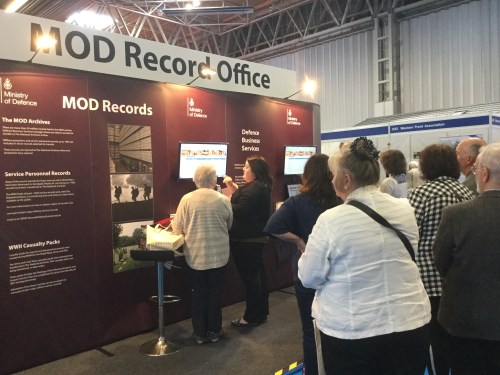





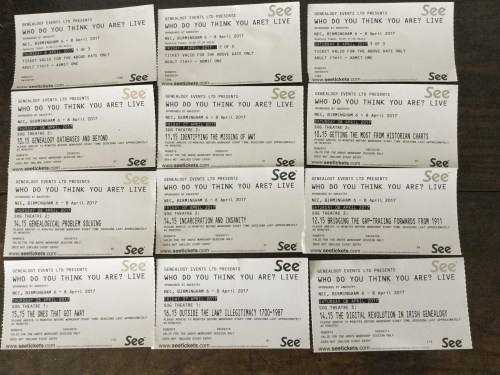
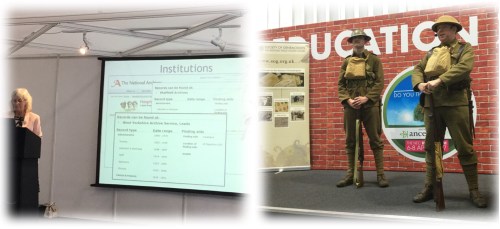
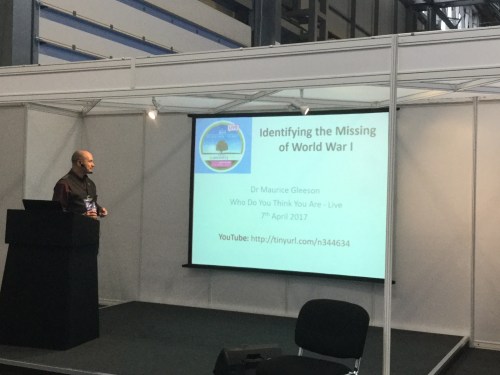


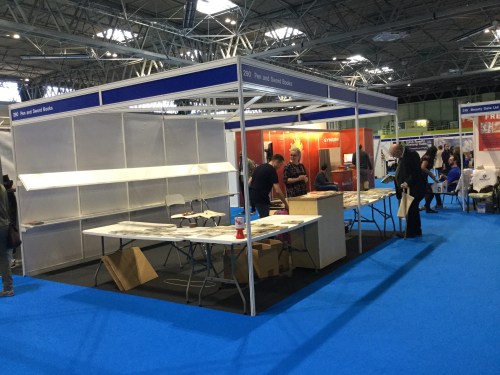
Sorry we didn’t get to catch up – thank you for buying one of my books 🙂
I went to your talk about “The Ones That Got Away” and on the basis of that I bought the book as I left the talk zone. So that shows how much I enjoyed it!
Sorry I didn’t spot you in the melee – maybe next year.
It was a pleasure to meet you Jane, and glad you had a great time at the show… slightly worried at how fearsome you look with that rifle though! :S
Likewise. That for me was the highlight – meeting everyone. As for the rifle, thankfully decommissioned because I’d not a clue what to do with it!